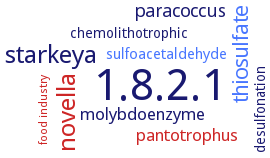1.8.2.1: sulfite dehydrogenase (cytochrome)
This is an abbreviated version!
For detailed information about sulfite dehydrogenase (cytochrome), go to the full flat file.

Word Map on EC 1.8.2.1 
-
1.8.2.1
-
starkeya
-
novella
-
thiosulfate
-
paracoccus
-
pantotrophus
-
molybdoenzyme
-
sulfoacetaldehyde
-
desulfonation
-
chemolithotrophic
-
food industry
- 1.8.2.1
-
starkeya
- novella
- thiosulfate
-
paracoccus
- pantotrophus
-
molybdoenzyme
- sulfoacetaldehyde
-
desulfonation
-
chemolithotrophic
- food industry
Reaction
Synonyms
CT1015, dehydrogenase, sulfite, MccACD, Mo-dependent sulfite dehydrogenase, More, multiheme cytochrome c sulfite reductase, SDH, SiR-FP18, SiRA, SO, SOR, SorA, SorAB, SorT, SoxF, sulfate oxidase, sulfite cytochrome c reductase, sulfite dehydrogenase, sulfite oxidase, sulfite oxidoreductase, sulfite reductase, sulfite-cytochrome c oxidoreductase, sulfite-oxidizing molybdenum enzyme, sulfite-oxido-reductase, sulfite: ferricytochrome-c oxidoreductase, sulphite:cytochrome c oxidoreductase
ECTree
Advanced search results
Engineering
Engineering on EC 1.8.2.1 - sulfite dehydrogenase (cytochrome)
Please wait a moment until all data is loaded. This message will disappear when all data is loaded.
C185A
the active site of the mutant is essentially catalytically inactive with ferricyctochrome c or ferricyanide as electron acceptor
C185S
the active site of the mutant is essentially catalytically inactive with ferricyctochrome c or ferricyanide as electron acceptor
G473A
-
mutant is able to dimerize and has steady-state activity comparable to that of the wild type, stopped-flow analysis of the reductive half-reaction of this variant yields a rate constant nearly 3 times higher than that of the wild type
G473D
-
monomer, mutant is severely impaired both in the ability to bind sulfite and in catalysis, with a second-order rate constant 5 orders of magnitude lower than that of the wild type, significant random-coil formation
G473W
-
monomer, mutant with 5fold higher activity than G473D and nearly wild-type activity at pH 7.0 when ferricyanide is the electron acceptor, significant random-coil formation
P105A
-
the mutant enzyme shows increased catalytic efficiency compared to the wild type enzyme
P105A/P111A
-
the mutant enzyme shows about 30% decreased catalytic efficiency compared to the wild type enzyme
P111A
-
the mutant enzyme shows about 30% decreased catalytic efficiency compared to the wild type enzyme
R212A/G473D
-
mutant is able to oligomerize but has undetectable activity, significant random-coil formation
R78K
the active site mutant is catalytically competent in sulfite oxidation activity
R78M
the active site mutant is catalytically competent in sulfite oxidation activity
R78Q
the active site mutant is catalytically competent in sulfite oxidation activity
H57A
R55K
-
heme potential is similar to wild-type, the molybdenum redox potential is not affected. Wild-type and mutant show pH dependence of the electrochemical catalytic halfwave potential
R55M
R55Q
-
heme potential is lowered from ca. 240 mV in wild-type to ca. 200 mV, the molybdenum redox potential is not affected
Y236F
mutant with reduced activity, Tyr-236 and His-57 are necessary to stabilize Arg-55 in a position for optimal hydrogen bonding to the heme 6-propionate
H57A
-
heme potential is lowered from ca. 240 mV in wild-type to ca. 200 mV, the molybdenum redox potential is not affected. The catalytic potential is pH-independent
mutant with reduced activity, R-55 is an important position close to the substrate binding site, where it makes hydrogen bonds to the equatorial oxo ligand of the molybdenum, to Gln-33, and a nearby water molecule. It also forms a salt bridge, comprising two hydrogen bonds, with propionate-6 of the heme moiety of the cytochrome subunit
R55M
-
heme potential is lowered from ca. 240 mV in wild-type to ca. 200 mV, the molybdenum redox potential is not affected. The catalytic potential is pH-independent
-
reduced turnover rates and substrate affinity as well as an altered reactivity toward molecular oxygen as an electron acceptor, unlike the wild type enzyme the mutant enzyme is reoxidized quickly in the presence of molecular oxygen
Y236F
mutant with reduced activity, Tyr-236 and His-57 are necessary to stabilize Arg-55 in a position for optimal hydrogen bonding to the heme 6-propionate


 results (
results ( results (
results ( top
top






